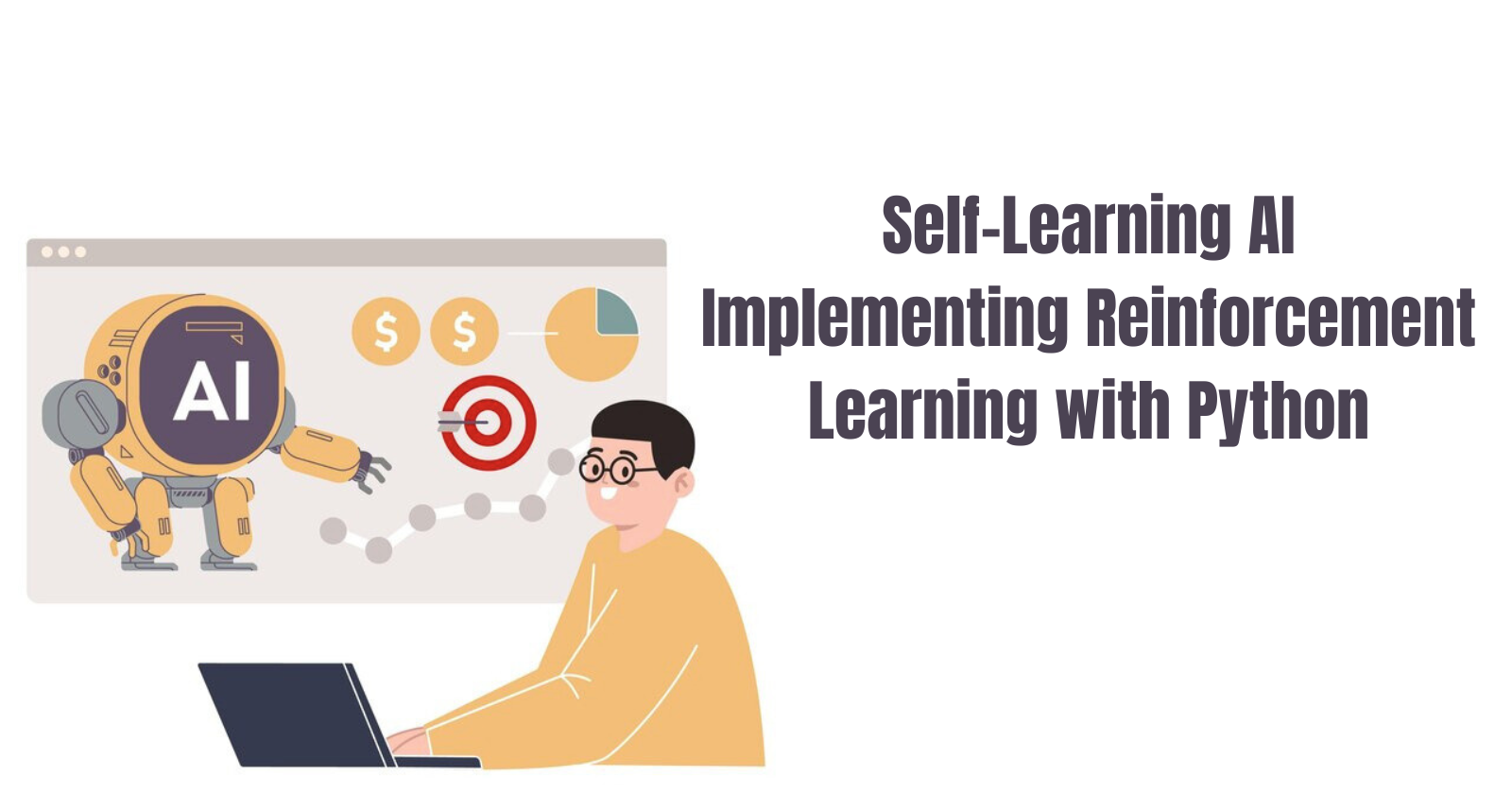Self-Learning AI: Implementing Reinforcement Learning with Python
 Dipen Patel
Dipen Patel
Artificial intelligence has evolved beyond traditional supervised and unsupervised learning models. Reinforcement learning (RL), a key subset of AI, allows systems to learn and improve through trial and error, much like humans. This approach enables AI to make sequential decisions, optimize processes, and enhance automation in various industries. From autonomous robots to game-playing AI, reinforcement learning is revolutionizing how machines interact with their environments.
With Python's extensive libraries and frameworks, implementing reinforcement learning has become more accessible than ever. Businesses leveraging Python machine learning can develop self-learning AI models that adapt to changing conditions, improve efficiency, and unlock new possibilities in automation. This article explores reinforcement learning, its core principles, implementation steps, and business applications.
Understanding Reinforcement Learning
Reinforcement learning is a machine learning technique where an AI agent learns by interacting with its environment. Unlike supervised learning, where labeled data guides the model, RL operates on a reward-based system. The agent takes actions, receives feedback in the form of rewards or penalties, and adjusts its strategy to maximize long-term success.
At the core of RL is the Markov Decision Process (MDP), which consists of states, actions, rewards, and a policy that guides decision-making. The AI explores different strategies through trial and error, refining its approach based on cumulative rewards. This self-learning mechanism allows AI to develop complex behaviors without explicit programming.
Python's ecosystem provides robust tools for RL implementation, including OpenAI Gym for training environments, TensorFlow and PyTorch for deep learning, and Stable Baselines for prebuilt reinforcement learning algorithms. These frameworks simplify the development of AI agents capable of solving complex decision-making problems.
Steps to Implement Reinforcement Learning with Python
Implementing reinforcement learning in Python involves several key steps, from defining the environment to training the AI agent. The first step is selecting an RL framework, such as OpenAI Gym, which provides prebuilt environments for training and testing AI models.
Next, the AI agent is defined using neural networks or traditional RL algorithms like Q-learning or Deep Q Networks (DQN). Python libraries like TensorFlow and PyTorch enable the development of deep reinforcement learning models that process high-dimensional data.
Once the agent is set up, the training process begins. The AI interacts with the environment, takes actions, receives feedback, and updates its policy using optimization techniques. Reinforcement learning requires extensive trial runs, often performed using cloud computing resources or high-performance GPUs to speed up training.
Businesses leveraging Python machine learning can customize RL models for various applications, such as automated stock trading, robotic process automation, and intelligent recommendation systems. Fine-tuning hyperparameters, reward structures, and exploration strategies ensures optimal AI performance.
Business Applications of Self-Learning AI
Reinforcement learning is transforming industries by enabling AI-driven decision-making and automation. In finance, RL-powered trading algorithms analyze market trends and execute profitable trades autonomously. These AI systems continuously learn from past transactions to improve accuracy and mitigate risks.
In healthcare, RL optimizes treatment plans by analyzing patient data and predicting the best medical interventions. AI models trained in Python machine learning frameworks can personalize treatment strategies based on real-time patient responses.
Retail and eCommerce platforms benefit from RL-driven recommendation engines that enhance customer experiences. By dynamically adjusting product recommendations based on user behavior, businesses can increase conversions and customer satisfaction.
Manufacturing industries utilize RL for predictive maintenance, where AI anticipates equipment failures and schedules proactive repairs. This reduces downtime, enhances efficiency, and minimizes operational costs.
Autonomous vehicles also rely on reinforcement learning to navigate complex environments, make real-time driving decisions, and improve safety. Self-learning AI enhances vehicle control systems by continuously refining driving strategies based on road conditions and traffic patterns.
Challenges in Reinforcement Learning Implementation
Despite its potential, reinforcement learning poses several challenges. Training RL models requires significant computational power, as AI agents must explore multiple strategies before converging on an optimal solution. Businesses implementing RL must invest in cloud-based AI infrastructure or specialized hardware like GPUs and TPUs.
Another challenge is defining reward functions that align with business objectives. Poorly designed rewards can lead to unintended AI behaviors, where models optimize for short-term gains instead of long-term success. Continuous monitoring and adjustment of RL strategies are crucial to ensure ethical and effective decision-making.
Data scarcity is another obstacle, as RL models require extensive training data to develop accurate policies. Simulated environments, such as Open AI Gym and Unity ML-Agents, help address this limitation by providing controlled training scenarios.
Security and ethical considerations also play a role in RL adoption. AI agents making autonomous decisions in sensitive domains, such as healthcare and finance, must comply with industry regulations and ethical guidelines. Businesses must implement safeguards to prevent biased decision-making and ensure transparency in AI-driven outcomes.
The Future of Self-Learning AI with Python
As reinforcement learning continues to evolve, advancements in deep learning and cloud computing are accelerating its adoption. Transfer learning, where AI agents apply knowledge from one domain to another, is enhancing RL model efficiency. This technique reduces training time and improves generalization across different environments.
Hybrid AI approaches, combining reinforcement learning with supervised and unsupervised learning, are creating more powerful AI systems. These models integrate historical data insights with real-time learning capabilities, improving adaptability and decision-making.
Edge AI is another emerging trend, enabling self-learning AI on low-power devices. By optimizing RL algorithms for edge computing, businesses can deploy intelligent automation in IoT applications, smart cities, and industrial automation.
The integration of reinforcement learning with Python frameworks ensures continuous innovation in AI development. As businesses explore new applications for self-learning AI, RL will play a crucial role in shaping the future of automation, optimization, and decision intelligence.
Conclusion
Reinforcement learning is revolutionizing AI by enabling self-learning systems that adapt and optimize through real-time feedback. Python's extensive ecosystem of machine learning libraries simplifies RL implementation, making it accessible for businesses seeking AI-driven automation.
From finance and healthcare to eCommerce and robotics, RL is unlocking new possibilities in intelligent decision-making. Businesses investing in Python machine learning can develop AI models that enhance efficiency, reduce costs, and drive innovation.
As AI continues to evolve, reinforcement learning will remain at the forefront of cutting-edge applications. Companies looking to integrate self-learning AI should explore RL frameworks, optimize training strategies, and embrace the future of adaptive intelligence.
Subscribe to my newsletter
Read articles from Dipen Patel directly inside your inbox. Subscribe to the newsletter, and don't miss out.
Written by

Dipen Patel
Dipen Patel
Dipen is an expert when it comes to Software Development & Programming in Full-stack and open-source environment. He has been working as the Chief Technology Officer at Quixom, providing a wide range of IT solutions to startups around the world. He is always up for a challenge. He works on building systems and solving problems at Quixom. When he is not working, he loves to watch movies and listen to music.